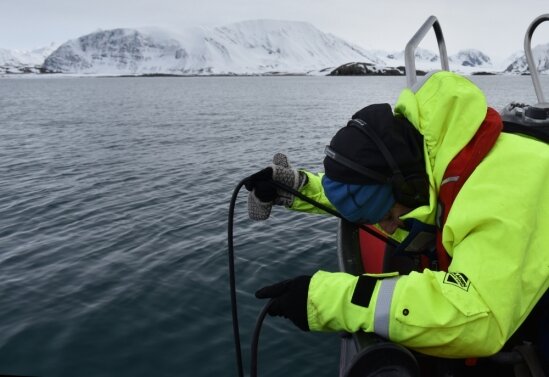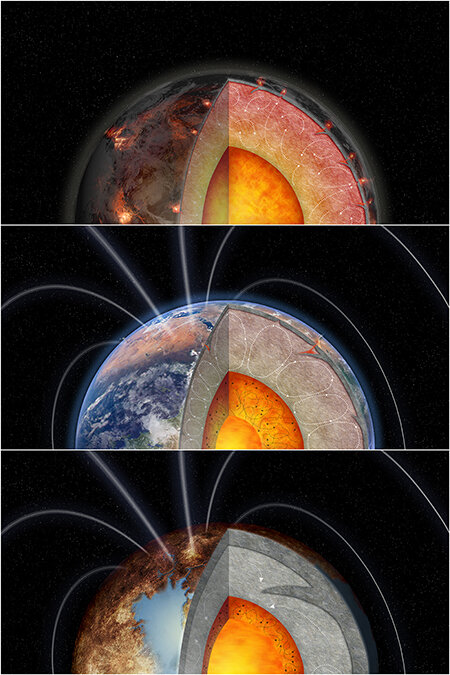#Healthy oceans need healthy soundscapes

“#Healthy oceans need healthy soundscapes”

Rain falls lightly on the ocean’s surface. Marine mammals chirp and squeal as they swim along. The pounding of surf along a distant shoreline heaves and thumps with metronomic regularity. These are the sounds that most of us associate with the marine environment. But the soundtrack of the healthy ocean no longer reflects the acoustic environment of today’s ocean, plagued with human-created noise.
A global team of researchers set out to understand how human-made noise affects wildlife, from invertebrates to whales, in the oceans, and found overwhelming evidence that marine fauna, and their ecosystems, are negatively impacted by noise. This noise disrupts their behavior, physiology, reproduction and, in extreme cases, causes mortality. The researchers call for human-induced noise to be considered a prevalent stressor at the global scale and for policy to be developed to mitigate its effects.
The research, led by Professor Carlos M. Duarte, distinguished professor at King Abdullah University of Science and Technology (KAUST), and published in the journal Science, is eye opening to the global prevalence and intensity of the impacts of ocean noise. Since the Industrial Revolution, humans have made the planet, the oceans in particular, noisier through fishing, shipping, infrastructure development and more, while also silencing the sounds from marine animals that dominated the pristine ocean.
“The landscape of sound—or soundscape—is such a powerful indicator of the health of an environment,” noted Ben Halpern, a coauthor on the study and director of the National Center for Ecological Analysis and Synthesis at UC Santa Barbara. “Like we have done in our cities on land, we have replaced the sounds of nature throughout the ocean with those of humans.”
The deterioration of habitats, such as coral reefs, seagrass meadows and kelp beds with overfishing, coastal development, climate change and other human pressures, have further silenced the characteristic sound that guides the larvae of fish and other animals drifting at sea into finding and settling on their habitats. The call home is no longer audible for many ecosystems and regions.
The Anthropocene marine environment, according to the researchers, is polluted by human-made sound and should be restored along sonic dimensions, and along those more traditional chemical and climatic. Yet, current frameworks to improve ocean health ignore the need to mitigate noise as a pre-requisite for a healthy ocean.
Sound travels far, and quickly, underwater. And marine animals are sensitive to sound, which they use as a prominent sensorial signal guiding all aspects of their behavior and ecology. “This makes the ocean soundscape one of the most important, and perhaps under-appreciated, aspects of the marine environment,” the study states. The authors’ hope is that the evidence presented in the paper will “prompt management actions … to reduce noise levels in the ocean, thereby allowing marine animals to re-establish their use of ocean sound.”
“We all know that no one really wants to live right next to a freeway because of the constant noise,” commented Halpern. “For animals in the ocean, it’s like having a mega-freeway in your backyard.”
The team set out to document the impact of noise on marine animals and on marine ecosystems around the world. They assessed the evidence contained across more than 10,000 papers to consolidate compelling evidence that human-made noise impacts marine life from invertebrates to whales across multiple levels, from behavior to physiology.
“This unprecedented effort, involving a major tour de force, has shown the overwhelming evidence for the prevalence of impacts from human-induced noise on marine animals, to the point that the urgency of taking action can no longer be ignored,” KAUST Ph.D. student Michelle Havlik said. The research involved scientists from Saudi Arabia, Denmark, the U.S. and the U.K., Australia, New Zealand, the Netherlands, Germany, Spain, Norway and Canada.
“The deep, dark ocean is conceived as a distant, remote ecosystem, even by marine scientists,” Duarte said. “However, as I was listening, years ago, to a hydrophone recording acquired off the U.S. West Coast, I was surprised to hear the clear sound of rain falling on the surface as the dominant sound in the deep-sea ocean environment. I then realized how acoustically connected the ocean surface, where most human noise is generated, is to the deep sea; just 1,000 m, less than 1 second apart!”
The takeaway of the review is that “mitigating the impacts of noise from human activities on marine life is key to achieving a healthier ocean.” The KAUST-led study identifies a number of actions that may come at a cost but are relatively easy to implement to improve the ocean soundscape and, in so doing, enable the recovery of marine life and the goal of sustainable use of the ocean. For example, simple technological innovations are already reducing propeller noise from ships, and policy could accelerate their use in the shipping industry and spawn new innovations.
Deploying these mitigation actions is a low hanging fruit as, unlike other forms of human pollution such as emissions of chemical pollutants and greenhouse gases, the effects of noise pollution cease upon reducing the noise, so the benefits are immediate. The study points to the quick response of marine animals to the human lockdown under COVID-19 as evidence for the potential rapid recovery from noise pollution.
Using sounds gathered from around the globe, multimedia artist and study coauthor Jana Winderen created a six-minute audio track that demonstrates both the peaceful calm, and the devastatingly jarring, acoustic aspects of life for marine animals. The research is truly eye opening, or rather ear opening, both in its groundbreaking scale as well as in its immediacy.
Under the sea, humans have changed ocean sounds
Carlos M. Duarte et al. The soundscape of the Anthropocene ocean, Science (2021). DOI: 10.1126/science.aba4658
Citation:
Healthy oceans need healthy soundscapes (2021, February 5)
retrieved 6 February 2021
from https://phys.org/news/2021-02-healthy-oceans-soundscapes.html
This document is subject to copyright. Apart from any fair dealing for the purpose of private study or research, no
part may be reproduced without the written permission. The content is provided for information purposes only.
If you liked the article, do not forget to share it with your friends. Follow us on Google News too, click on the star and choose us from your favorites.
For forums sites go to Forum.BuradaBiliyorum.Com
If you want to read more Like this articles, you can visit our Science category.


